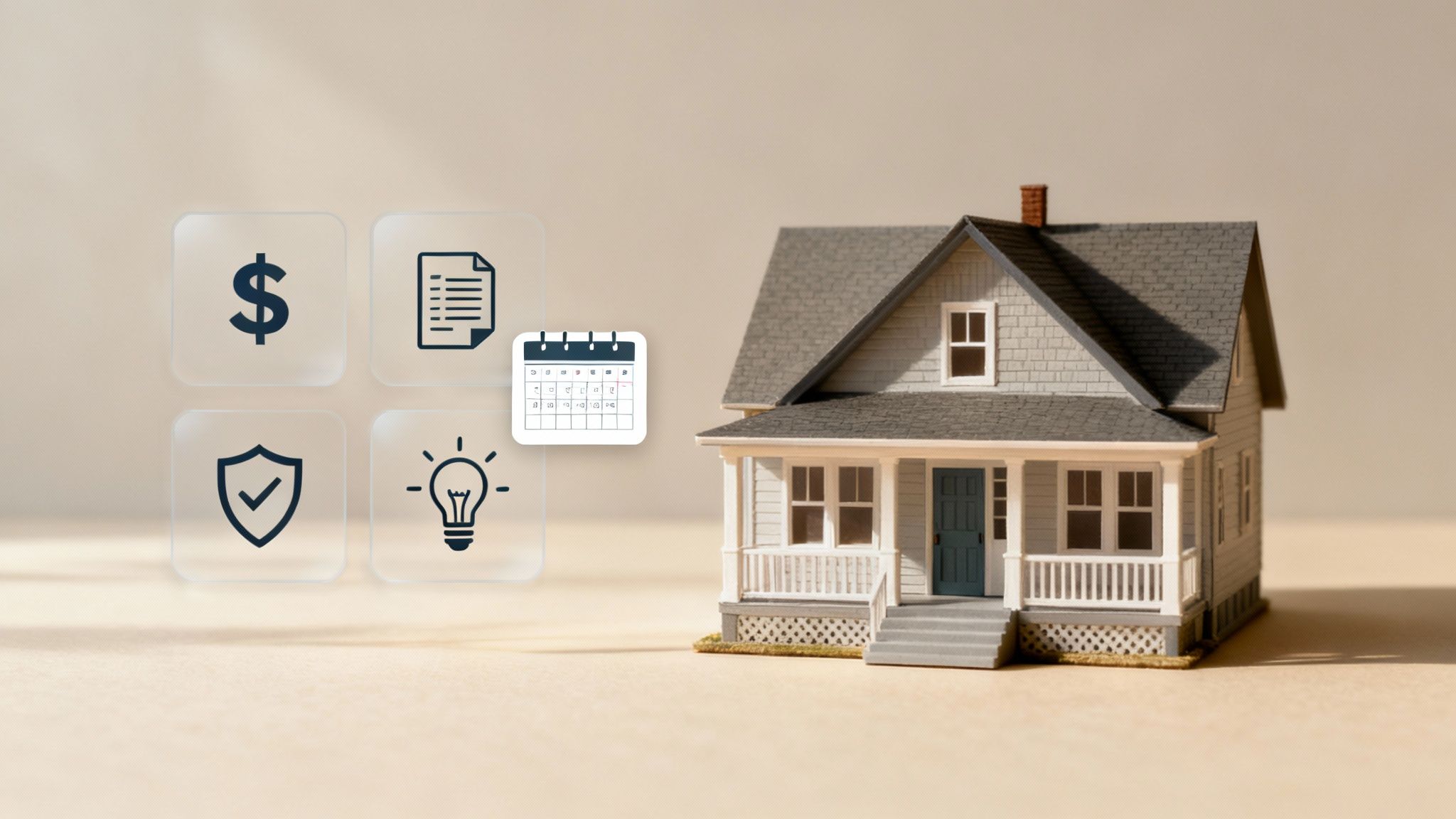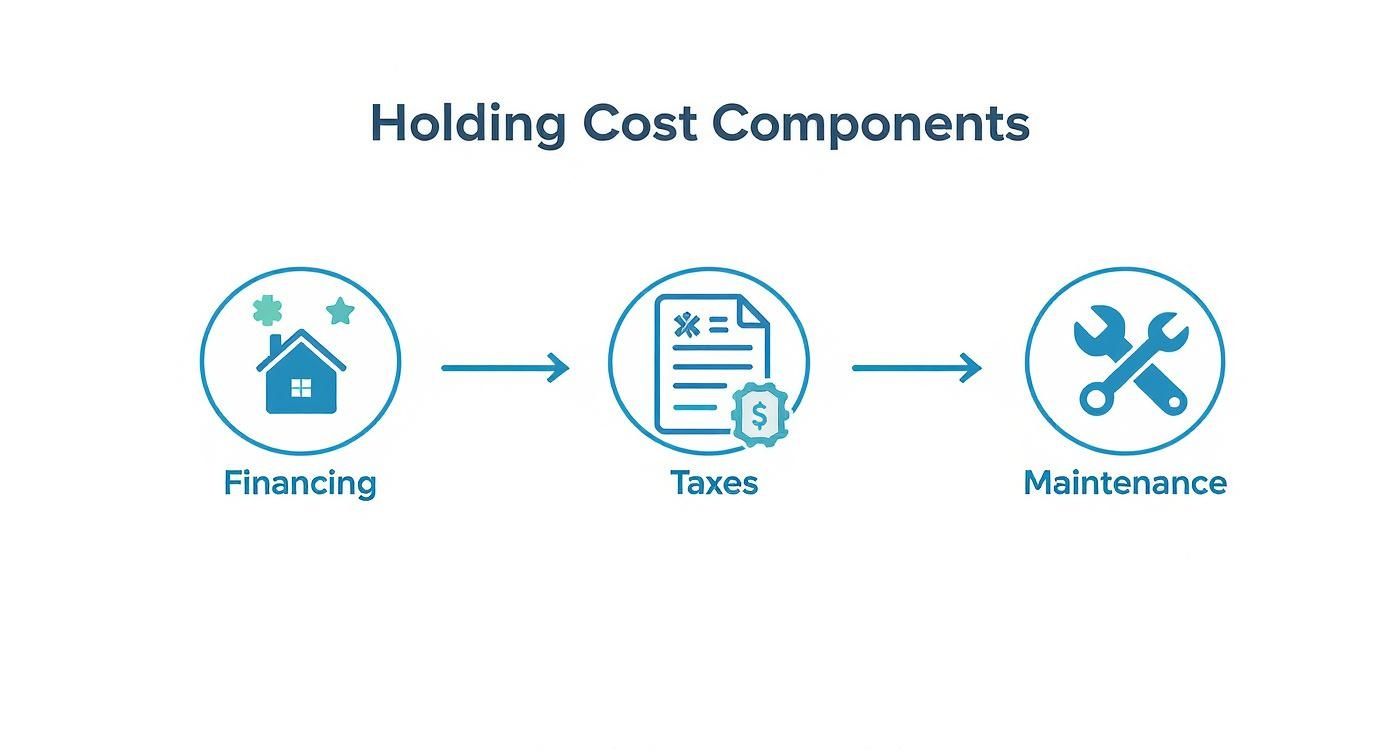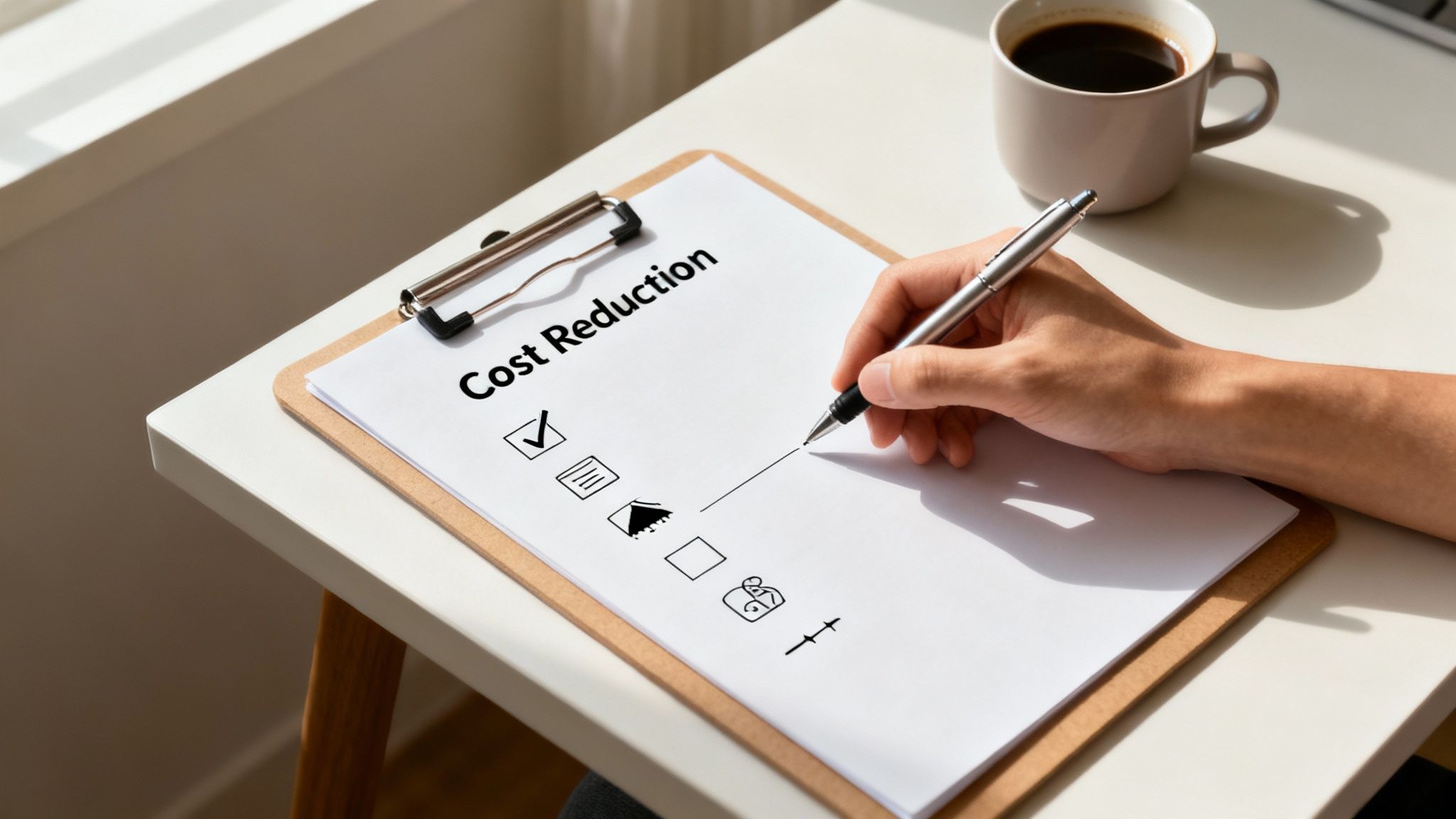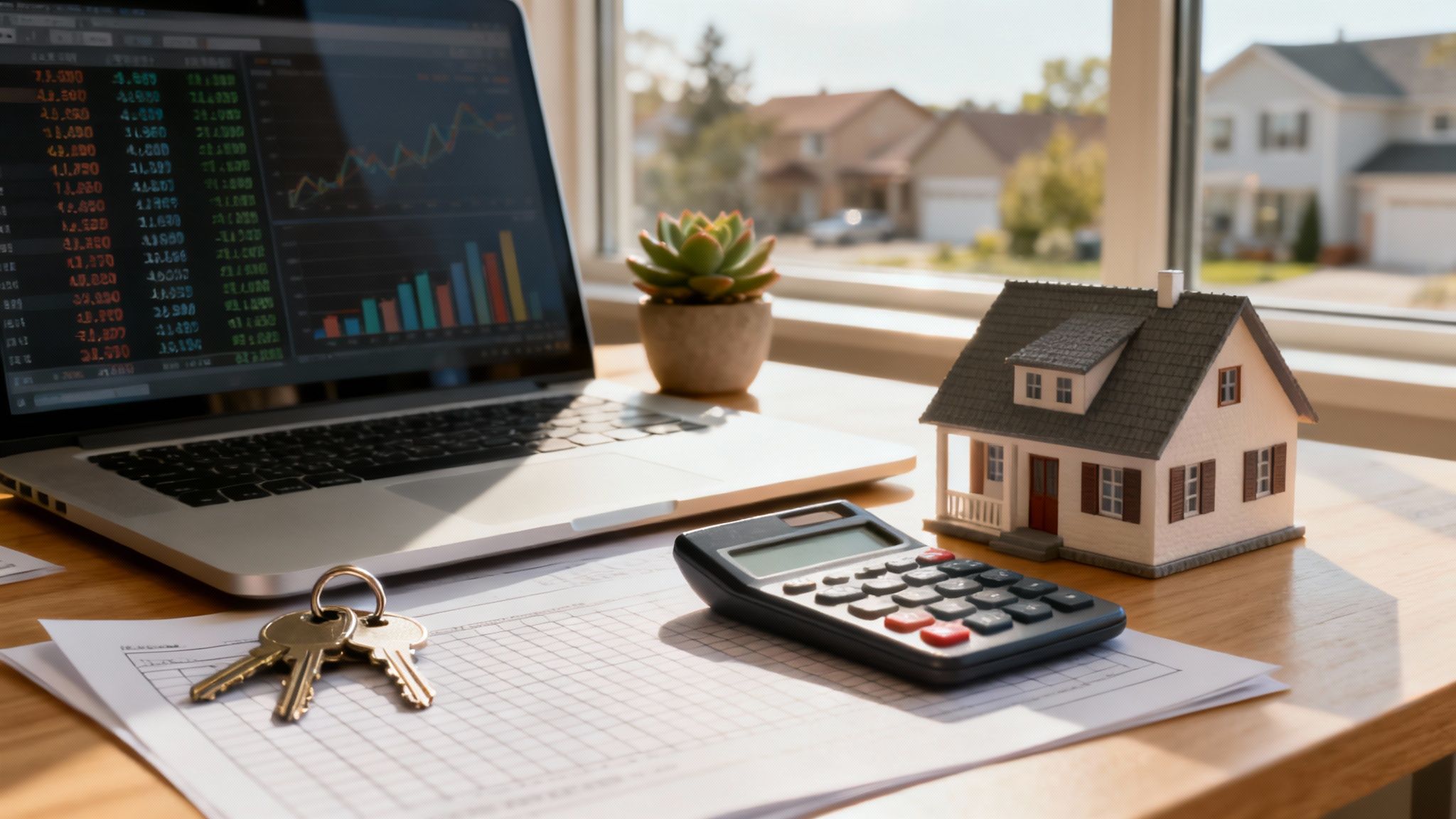Calculating holding costs is simpler than it sounds. At its core, you're just adding up all the recurring expenses you’ll pay from the moment you own the property until you sell it or a tenant moves in. This includes everything from loan payments and property taxes to utilities and basic insurance. Getting this number right is the first step to a profitable deal.
Quick Takeaways:
- Holding costs are all recurring expenses from purchase to sale or tenant occupancy.
- Main categories: Financing, Taxes & Insurance, Utilities, Maintenance, HOA Dues.
- Accurate estimates help you avoid surprises and protect your profit margin.
What Are Real Estate Holding Costs?

Before building a solid forecast for any investment, you need to get a handle on what holding costs really are. Think of them as the steady, quiet expenses that start the moment you take ownership and don’t stop until you either sell the place or a tenant begins paying rent.
These costs tick away while a property is vacant or under renovation. They are the silent profit killers that can quickly turn a promising deal into a financial headache if you don’t account for them properly.
Why Holding Costs Matter So Much
Understanding and accurately predicting these expenses is critical. For fix-and-flip investors, every single day the property sits on the market, these costs pile up, chipping away at your profit margin. For landlords, they define the cost of your vacancy period—the gap between tenants when no rent covers the bills.
A precise holding cost calculation is the foundation of any successful real estate deal. Miscalculating by even a small margin can mean the difference between profit and loss.
Misjudging holding costs doesn’t just mess up your numbers; it creates a fundamentally broken business plan. You could overpay for a property, underestimate cash reserves, or set yourself up with unrealistic profit goals. Lock in that core concept before moving on.
The Core Components to Consider
We’ll break down every component in detail later, but to get started, you’ll always need to account for these main categories:
Holding Cost Components at a Glance
| Cost Category | Description | Example Expenses |
|---|---|---|
| Financing Costs | Expenses tied to the loan used to purchase | Mortgage Principal & Interest, PMI, Hard Money Payments |
| Taxes & Insurance | Mandatory government fees and protection costs | Property Taxes, Homeowners/Builder’s Risk Insurance |
| Utilities | Essential services to maintain the property | Electricity, Water/Sewer, Gas, Trash |
| Maintenance | Routine upkeep | Lawn Care, Snow Removal, Pest Control, Pool Service |
| HOA Dues | Fees for homeowners’ association, if applicable | Monthly/Quarterly HOA Fees, Special Assessments |
By adding up these recurring expenses over your projected timeline, you get a clear picture of the true cost to own the property before it starts making you money. This number is the essential baseline for every other calculation.
Nailing Down Every Single Holding Cost
To get your holding costs right, you have to play detective. Every successful deal I’ve done started with a ruthless hunt for every possible expense, no matter how small. It’s the little costs people often forget that compound over time and eat away at profit.
A truly accurate calculation lives in the details. Let’s break down all the potential costs organized so you won’t miss a thing—your go-to framework for building a budget you can actually trust.
Financing and Capital Costs
This is usually the biggest chunk of your holding costs. If you’re using leverage to buy the property, these are the expenses tied directly to that loan.
- Mortgage or Loan Payments: Covers your principal and interest each month. For hard money loans, this is often interest-only but still a hefty bill.
- Loan Fees: Origination fees, points, and other closing costs should be baked into your total capital cost.
- Private Mortgage Insurance (PMI): If you brought less than 20% down on a conventional loan, you’re likely paying PMI—a monthly fee that protects the lender, not you.
Property-Specific Obligations
These are non-negotiables that come with property ownership. They’re predictable but vary widely by location.
- Property Taxes: Pull the property’s tax history from the local assessor’s website to get accurate rates.
- Homeowners Insurance: Required for a loan—protects your investment from disasters. Renovations need builder’s risk insurance.
- HOA or Condo Fees: Monthly or quarterly dues, plus potential special assessments for major community projects.
Quick Takeaway: Always verify property taxes and HOA fees during due diligence. A high HOA fee can turn a great deal into a money pit.
And if you’re doing a renovation, don’t forget business insurance for contractors—it affects your overall budget.
Operational and Maintenance Expenses
This is where investors often slip up. These “death by a thousand cuts” costs keep your property safe and sound while you own it.
- Utilities: Even a vacant house has bills. Get estimates from local providers.
- Routine Maintenance: Lawn care, snow removal, gutter cleaning.
- Landscaping: At minimum, mowing and trimming to keep curb appeal.
- Pest Control: Depending on location and condition, this may be recurring.
Meticulously listing every item stops guessing and starts forecasting based on data. This detailed budget is your best defense against unexpected costs.
Calculating Holding Costs for a Fix and Flip
When you’re flipping, the clock is your biggest enemy. Every single day you own that property, your holding costs drain potential profit.
Formula: Total Holding Costs = (Sum of Monthly Expenses) × Number of Months Held.
Breaking Down the Monthly Burn
Your monthly burn rate is the sum of all recurring expenses to keep the project alive. Example for a four-month flip:
- Hard Money Loan Payment: $250,000 loan at 10% interest → $2,083/month
- Property Taxes: $3,600/year → $300/month
- Builder’s Risk Insurance:$150/month
- Utilities:$200/month
- Basic Maintenance:$100/month
Total Monthly Burn Rate: $2,833

The Most Important Variable: Time
With a $2,833 monthly burn, a perfect four-month flip costs $11,332. Slip into a six-month timeline? $16,998—that extra $5,666 slashes right into your profit.
Managing your timeline is as crucial as managing your rehab budget. Every delay piles on more holding costs.
Build a contingency buffer. If you think three months, budget for four or five to cushion unexpected delays.
Real-World Fix-and-Flip Scenario
Projected Holding Period: 5 Months
Monthly Holding Cost: $2,833
Total Budgeted Holding Costs: 5 × $2,833 = $14,165
This $14,165 is the number you bake into your deal analysis from day one. For tools to help automate this math, check out your ultimate guide to using a fix and flip calculator.
Forecasting Holding Costs for a Rental Property
https://www.youtube.com/embed/3k6NaWtBUOs
With a rental property, holding costs become a permanent, recurring part of your model. Forecasting these right dictates your rent price, shapes cash flow, and drives deal viability.
Adapting the Calculation for Long-Term Holds
Calculate a reliable monthly and annual expense forecast as the backbone of your Net Operating Income (NOI): Total Income – Operating Expenses. Holding costs are your biggest operating expenses.
Key Expenses Unique to Rental Properties
- Property Management Fees: 8–12% of monthly rent.
- Vacancy Reserves: Budget 5–10% of rent to cover gaps.
- Repairs & Maintenance: Set aside 1% of property value per year.
Use a detailed rental property maintenance checklist to spot all recurring chores.
Don’t Forget Capital Expenditures (CapEx)
CapEx covers major replacements—roof, HVAC, water heater. Estimate remaining life and save monthly. Example: $6,000 HVAC lasting 15 years → $33/month.
Single-Family Rental Example
Rent: $2,200/month
| Expense | Amount |
|---|---|
| Mortgage (P&I) | $1,200 |
| Property Taxes | $300 |
| Homeowners Insurance | $100 |
| Vacancy Reserve (8%) | $176 |
| Repairs & Maintenance | $200 |
| CapEx Reserve | $150 |
| Property Management (10%) | $220 |
| Total Monthly Holding Costs | $2,346 |
At $2,346 in costs vs. $2,200 rent, you have a -$146 monthly shortfall. That black-and-white clarity tells you to renegotiate purchase price, cut expenses, or walk away.
Proven Strategies to Slash Your Holding Costs

Knowing how to calculate holding costs is only half the battle. The real money is made by actively reducing those numbers. Shaving just a few hundred dollars off your monthly burn can add thousands back over a project’s life.
Optimize Your Financing
Your loan is usually the biggest slice of holding costs. Shop lenders and negotiate terms:
- Shop Multiple Lenders: Check national banks, credit unions, and hard money lenders.
- Negotiate Loan Terms: Ask about waiving fees or reducing points.
Shorten Your Flip Timeline
Time is money. Line up materials and contractors before closing. Use a real estate due diligence checklist to prevent delays.
Pro Tip: Create a detailed schedule with hard deadlines and share it with your crew for shared urgency.
Keep Operating Expenses in Check
Don’t ignore “small” recurring expenses:
- Shop homeowner or builder’s risk insurance annually.
- Conduct proactive maintenance to avoid big repair bills.
- Screen tenants rigorously to minimize vacancy and damage.
By managing financing, timeline, and operations, you turn holding costs from a fixed burden into a variable you can control.
Common Questions About Holding Costs
As you dive into deal analysis, the same questions pop up. Getting these right separates a rough guess from a bankable estimate.
How Do I Estimate Holding Costs Before I Own the Property?
Use public records and quick calls to gather real numbers:
- Property Taxes: County assessor’s website for tax history.
- Utilities: Call local providers for average bills.
- Insurance: Get a quote from an agent.
- HOA Dues: Ask the management company about current fees and upcoming assessments.
Use an online mortgage calculator to estimate financing costs.
What’s the Biggest Mistake Investors Make?
Underestimating the holding period on flips. Always add a 25–50% time contingency to your schedule to cover permit delays, contractor issues, and surprises behind walls.
Should I Include My Own Labor in Holding Costs?
Yes. Assign a market-rate value to your hours to measure true ROI and build a scalable model that accounts for paying future team members.
How Can I Reduce Holding Costs Quickly?
- Shop multiple lenders to lower interest and fees.
- Plan and schedule renovations in advance to avoid downtime.
- Bundle services (insurance, maintenance) for volume discounts.
- Screen tenants to minimize vacancies and damage.
Stop guessing and start analyzing. Flip Smart gives you the power to evaluate any property in seconds, providing clear valuations, rehab costs, and profit potential. https://flipsmrt.com
